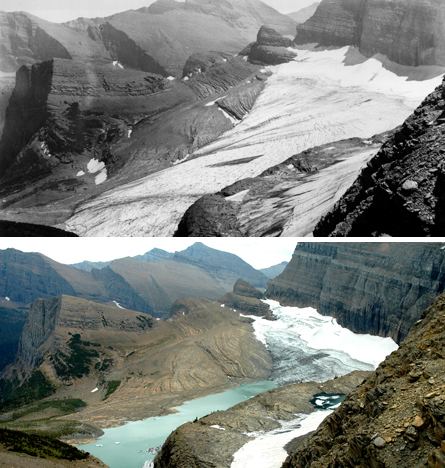GNP’s glaciers: Going, going . . .
Climate warming will eliminate them within a generation, data indicate
Glacier National Park , Montana The nation’s tenth national park — once home to some 150 named glaciers — is running out of ice fields. Century-old Glacier National Park has but 25 glaciers left. And computer models by federal scientists working at the park indicate that within another decade — at most two — the only place to see the region’s glaciers will be in historic photos.
The problem: The region’s climate has been warming, notes Erich Peitzsch of the U.S. Geological Survey, who studies snow and ice at the park. Speaking with reporters, October 14, as part of a field trip associated with the Society of Environmental Journalists’ annual meeting in Missoula, Mont., he described the park’s slowly elevating fever.

Throughout the past century, for instance, this locale has experienced a quadrupling in the annual number of extremely hot days. In the early 20th century, just five days a year exceeded 90 °F (32.2 °C). By 2006 (the last year analyzed), the average had risen to roughly 20. This has led to a longer window of peak temps. While baking summer heat used to start around the second week in July and extend through maybe the second week in August, it now typically begins in late June and continues to around August 25.
The annual number of days hovering at or below freezing have also diminished over the past century — from about 186 days a year to 170 now. The sharpest decline in this trend: since 1986. One consequence: spring thaws now arrive about three weeks earlier than a century ago.
Driving this 100-year-trend, Western Montana — where this national park resides — has experienced a more than 3 °F increase in its annual average temperature. That’s almost double the warming increase experienced worldwide over the same period, according to a paper earlier this year in Climatic Change by researchers with USGS and the University of Arizona.
Of course, “Glacier [National Park] is not the only place that we are seeing direct effects of climate change on the ground right now,” observes National Park Service director Jon Jarvis. “For instance, Mt. Rainier National Park, where I was the superintendent, is seeing a shift in what had been traditional for the climate.” Usually rain served to begin melting the park’s snowpack in spring. Now significant melting rains also come in the fall, he says, leading to substantial flooding and stream-bank erosion. “We’re also seeing fires burn on average 20 days longer each year.” Blazes initiate earlier in the summer and end later.
“The facts — and the science — around climate change are indisputable,” Jarvis says. That’s why his agency is seeking, park by park, to not only reduce its carbon footprint, he says, but also to create adaptation plans for coping with climate change.
Many of the options will fail iconic species, he acknowledges. “My senior scientist in California put it rather succinctly, if sarcastically, when he said: ‘When are you going to be ready to put a sprinkler system on the giant sequoias?’”
As for Glacier park’s own icons — its ice fields — won’t it be ironic if they vanish? Not really, contends park spokeswoman Amy Vanderbilt. This million-acre expanse of mountains and wilderness took its name from having been shaped by glacial activity during past Ice Ages — not from the presence of residual ice fields. So its name will still fit, she contends, when a dozen or so years from now its peaks end up glacierfree.
See also: When to welcome ‘invasive’ species







